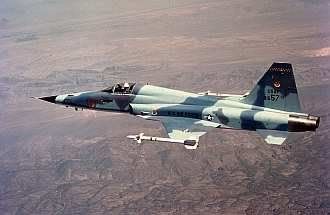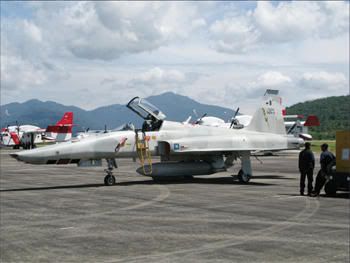

OLD BUT WORTHY: This RMAF Tigereye reconnaissance plane was put on show at Lima 2009.
The missing F5-E fighter jet engines are giving the local police force the run-around. After 1 years there is still no sufficient process by the police investigators.
More than two years after two F5-E fighter jet engines were stolen and a year after the theft was discovered, police investigators are finally looking for documents to provide clues as to how the equipment could have been taken out of the country.
In a case that has become a major embarrassment for Malaysia and Prime Minister Datuk Seri Najib Razak, who was Defence Minister at the times the engines were stolen, investigators have lingered over the case since the Royal Malaysian Air Force first lodged a report last August.
But since the thefts were publicly revealed recently, the authorities have come under pressure to explain why the case has taken so long to investigate and to deny claims of a cover up.
Inspector-General of Police Tan Sri Musa Hassan said today that investigators are now trying to locate important documents linked to the missing F5-E fighter jet engines.
“We have conducted a thorough investigation and have submitted investigation reports to the Attorney-General so that further action can be taken to charge those involved.
“But the A-G has since then informed the police to conduct more investigations in order to find the important documents which contain details on how the engines could be shipped out of the country in the first place,” said Musa.
Musa’s statement comes just a day after A-G Tan Sri Abdul Gani Patail had given his assurance that his chambers would go all out to solve the case.
The case of the two missing jet engines first came to light after a daily newspaper had reported that the RMAF had lost two F5-E engines from its Butterworth base between June and
November 2007 and only realised it in May the following year.
The thefts were discovered when Armed Forces Chief Gen Azizan Ariffin, who was then then Air Force Chief, ordered an audit of the force’s assets.
A police report was only lodged last year and it was also reported that a brigadier-general and 40 personnel from the RMAF were sacked then over their alleged involvement.
When asked whether more arrests had been made since the case had been highlighted in the media, Musa stressed that action was constantly being taken.
“If there are more suspects that we find, I will take action. Do not forget that this also involves accusations made on an international level,” said the IGP.
The United States is not expected to punish Malaysia over the F5 jet components-for-sale racket.
Local defence industry sources told The Malay Mail it was unlikely the US would impose any action against Malaysia as the sale of the components was done illegally.
Two J85-GE-21 jet engines that power the F-5 fighters were stolen from two Royal Malaysian Air Force (RMAF) facilities in 2007 while some components from the same planes were also unaccounted for.
"It is not as if the Malaysian government had sanctioned the deal. We may be told through diplomatic channels to tighten up security at our military facilities but it is unlikely that it will effect ties between our countries," a source said.
Furthermore, the items stolen were considered old technology and did not involve weapons.
Defence Minister Datuk Seri Dr Ahmad Zahid Hamidi said yesterday the report on the stolen F5 components, including the two J85-GE-21 engines, would be forwarded to the US.
It would be handed to the US authorities through the Malaysian ambassador to the US, Datuk Seri Jamaluddin Jarjis.
The two jet engines were reportedly stolen in June and November, 2007. The theft of the engines and and other components from the jets, worth millions of ringgit, were discovered in late 2007, following an internal audit carried out by the RMAF top brass. However, the air force only made a police report on this in August last year.
The Malay Mail had reported that some personnel implicated in the F5 jet components for sale racket had allegedly accepted RM200 "to look the other way" when the components were taken out from the Sungai Besi air base.
The personnel were bribed by a man working for a local aviation company, described as the mastermind of the racket.
The case is being investigated by the Federal Commercial Crime Investigation Department in Bukit Aman, Kuala Lumpur.
It was believed that RMAF personnel working with the mastermind had sent the engines and other components to a neighbouring country by declaring that the equipment needed to be repaired abroad.
Once the components arrived in the neighbouring country, they were sold to international arms dealers by the mastermind's accomplice.
RMAF began operating the F5s in 1974. In 1999, the air force replaced the aircraft with MiG-29N and F/A-18D jets. However in 2003, the F5s, then aged 29 years in the RMAF inventory, were re-activated as training and reconnaissance aircraft to meet current needs.
At least seven F5s remain in service, three single-seat F5E Tiger II fighters, two RF-5E Tigereye reconnaissance planes and two twin-seater F5F trainers.
Attorney General said engine thief is serious.
Describing the disappearance of two F5-E fighter jet engines as a “serious matter”, Attorney-General Tan Sri Abdul Gani Patail today gave the assurance that his chambers would go all-out to solve the case.
“It is a serious matter. To my knowledge, it is two engines, and what makes matters worse is that the loss was discovered about a year later. I need a full investigation. I think the public deserves to know,” he said.
It was reported last week that the two Royal Malaysian Air Force (RMAF) F5-E fighter jet engines were missing, prompting the authorities to conduct an investigation.
In an interview with Bernama here, Abdul Gani admitted that it would not be an easy case as it involved a range of agencies — ministries, transport and forwarding agencies, the security network, and companies involved in repairing engines.
He said the military conducted its own investigation and then decided to lodge a police report more than a year after the engines went missing.
And, about six months ago, the case was referred to the AG’s Chambers for further investigation.
“I have directed my people to conduct a complete check, the entire movement of the two engines, and I want to know where the engines are now. “This is not a simple matter. It is a concerted effort by a group of people,” he noted.
Abdul Gani was in New Delhi to deliver a lecture of the Asian-African Legal Consultative Organisation (AALCO) lecture seriesMystery and coverups Jet Engines theft deepens.
- The RMAF lodged a report after six months of finding the engines missing from high security warehouse.
- Brigarial General and 40 staffs that are fired before the engines are found missing,how then they are involved?
- Why during that time Defence Minister Najib and PM Badawi did not inform the public abt the theft.
- Why there is no progress even after 1 year investigation by the Police?
- Alleged sold to Iran .Iran has already 65 F5 A,B,E and F variants .Why want an obsolete technology?
The Royal Malaysian Air Force (RMAF) has now said a brigadier-general and several others sacked in 2007 have nothing to do with the embarrassing theft of two F-5E jet engines found only missing in 2008.
That makes sense.
After all, how can they be sacked before the theft was discovered?
But there precious little sense and details of the theft that has put international spotlight on Malaysia’s lax security, possible role in the global black market arms trade and corruption that has put the country at 56 in the Transparency International graft rankings.
The police are now saying the engines — the General Electric J85-21A turbojets — have been traced to Argentina. It apparently went there by way of a Middle-East nation, believed to be Iran, from Port Klang. And police are now looking for the documentation for the shipping.
No one has yet shed light how the thieves sneaked the engines, the size of a small car, out of the RMAF Sungei Besi airbase, to the port. It is also not known why the engines, said to be spares, are kept in Sungei Besi when the F-5E squadron is based in the RMAF Butterworth airbase.
The greater mystery is why would anyone want to acquire jet engines first made 30 years ago? No one has yet to reveal the answer to that, especially when the RMAF has the F/A-18Ds and the MiG-29Ns using far superior powerplants made with better technology.
For the record, Malaysia bought the 14 F-5Es in 1974 and decommissioned them in 1999. One crashed in the Malacca Strait near Perak on May 31, 1995. There are 13 now but only six are operational after they came back to service in 2003.
Selling the jet engines to Iran also does not make sense as the Islamic republic has 65 F-5 of the A, B, E and F variants, according to Wikipedia. The United States had sold them to Iran in the 1970s when the Shah was in power before being toppled in 1979.
Why would Iran want technology for a jet engine it already possesses? All the more so when its an engine made in the 1970s. Iran already has scientists said to be working on military-capable nuclear technology, so this jet engine technology is obsolete for it.
Of course, the languid response to the theft and an apparent lack of outrage when it was first discovered is shocking. And a mystery.
The RMAF lodged a report after six months of finding the engines missing. The police took a glacial pace of more than a year to investigate before sending the papers to the Attorney-General’s Chambers. And he is only now saying it is a “serious matter” after it finally became public, asking the police to probe further.
Prime Minister Datuk Seri Najib Razak, who was the then Defence Minister, never revealed it. Neither did the Prime Minister Tun Abdullah Ahmad Badawi. Why? The mystery deepens.
We have two jet engines stolen two years ago from a secure military installation. They are allegedly now in Argentina.
We appear to know the what, where and when. It is the who, why and how that is missing, somewhat like the engines.
The mystery is just getting curiouser by the day, for the more we know, the less we understand this crime that underscores the public perception of the Malaysian government and the civil service.


